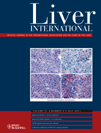Serum chemokine receptor CXCR3 ligands are associated with progression, organ dysfunction and complications of chronic liver diseases
Abstract
Background: Chemokines are chemotactic mediators that are implicated in liver diseases. In viral hepatitis and primary biliary cirrhosis, a predominant chemokine receptor expressed in the liver is CXCR3, suggesting that its specific ligands are important in the progression of chronic liver diseases across different aetiologies.
Methodology/Principal findings: We analysed the serum concentrations of the CXCR3 ligands, CXCL9 (monokine induced by interferon-γ), CXCL10 (interferon-γ-inducible protein 10) and CXCL11 (interferon-inducible T cell α chemo-attractant) in healthy controls (n=53), subjects with histologically determined liver fibrosis (n=109) and patients with different stages of cirrhosis (n=153) of various disease aetiologies. Chemokine concentrations were determined by cytometric bead assay or ELISA respectively. Serum concentrations of all three chemokines were significantly increased in patients with chronic liver diseases compared with healthy controls (P<0.001). In the biopsied fibrosis cohort, CXCL9 and CXCL10 were positively associated with the severity of liver fibrosis (histology and serum markers), while CXCL11 was not. In cirrhotic patients, CXCL9 was increased in early Child–Pugh stages, while CXCL11 was elevated only in Child B and C patients and CXCL10 across all stages. Notably, CXCR3 chemokines were also associated with the development of clinical complications of cirrhosis, especially portal hypertension. All chemokines significantly correlated with serum levels of the hepatoprotective cytokines interleukin (IL)-6 and IL-10, suggesting their involvement in a counter-regulatory response during the progression of liver disease, shedding new light on their involvement in the pathophysiology of chronic liver diseases.
Conclusions: CXCR3 chemokines are differentially expressed during chronic liver diseases across different disease stages and aetiologies. Their association with portal hypertension and hepatoprotective cytokines implies biological functions beyond immune cell recruitment, thereby provoking new diagnostic and therapeutic concepts.




